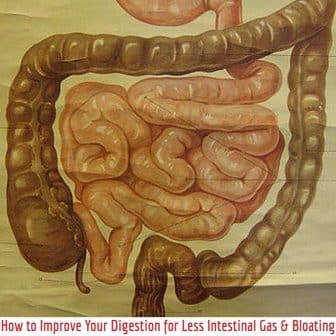How Grains with Gluten & Fructans Can Damage Your Digestion
In this article:
- Why grain foods like wheat can irritate the intestinal lining and cause digestive problems for a growing number of people.
- Which foods contain the most gluten and a list of gluten free alternatives.
- How to do a 2 day grain free test to reduce gastrointestinal issues and improve your energy levels and mental focus.
Grain Foods and Digestive Problems
Grains like wheat, barley and rye contain two problematic substances for anyone experiencing gastrointestinal issues like bloating, abdominal pain, intestinal cramps, diarrhea, constipation and excessive gas.
The first are fructans. These indigestible carbohydrates are completely malabsorbed in your digestive tract. Instead they are passed on to your colon where they promote bacterial growth and gas production.
Wheat products contribute the vast majority of fructans in most people’s diets. Rye and barley are also high in fructans, but these grains aren’t usually eaten as often as wheat.
The second substance found in wheat, barley and rye that can cause digestive problems is a combination of proteins collectively known as gluten. While gluten doesn’t directly feed intestinal bacteria in the same way as fructans and other indigestible carbohydrates, it can cause gastrointestinal distress for a growing number of people.
The Problem with Gluten
The most serious health issue associated with eating foods with gluten is celiac disease, an autoimmune condition that damages the intestines, hampers nutrient absorption and can even be life-threatening. Beyond the small percentage of the population with celiac disease, more and more people appear to be suffering from a negative reaction to gluten.
Gluten intolerance leads to your body treating undigested gluten proteins as foreign invaders. This irritates your intestinal lining and can be the source of many digestive issues. It also damages the delicate microvilli in the small intestine that absorb nutrients from your food.
With decreased nutrient absorption, deficiencies become more common and symptoms like fatigue, anemia, nausea, skin complaints and depression are often reported with gluten intolerance.
Various theories have been put forward for the significant rise in gluten intolerance in recent years. Some specialists, like Dr. Davis, author of Wheat Belly, say that wheat strains have been bred in recent decades to dramatically increase gluten content.
Others point to commercial bread bakeries speeding up the rising time of bread, from hours in the past to no more than a few minutes. This leaves more gluten in the bread loaf and may be why sourdough bread, with its much longer rising time, is usually better tolerated by gluten sensitive people than regular supermarket bread.
Gluten is also now directly added as an extra ingredient to bread and many other foods. So much so that US imports of pure gluten more than doubled between 1997 and 2007.
Regardless of the causes behind gluten intolerance, it’s a growing health issue with millions of people suffering from digestive problems due to gluten.
Some commentators suggest that virtually all people are sensitive to gluten at high enough levels. So, as our intake of this difficult to digest protein has increased, so too has the number of people suffering from gluten intolerance.
Cutting Back on Wheat and Other Grain Foods for Better Health
All in all, there are many good reasons to minimize grain foods and particularly processed wheat products that provide your body with next to no nutritional value. Not only will you avoid digestion problems with gluten and fructans, you’ll also greatly reduce your risk of diabetes, heart disease and obesity from high carbohydrate consumption.
The following list of high gluten foods may be hard to read for some. If your gluten sensitivity is mild, then you may see improvement just by reducing some of the highest sources, like supermarket breads and pasta.
However, if you are gluten intolerant then it’s important to make the switch to the gluten free alternatives ahead.
Fortunately, most gluten free alternatives to wheat, barley and rye are also low in fructans, so avoiding one will also generally avoid the other. The only exception to this is gluten-free products still made from wheat, barley or rye. These are usually still high sources of indigestible fructans.
High Gluten Foods
- Bread made with wheat
- Rye bread
- Pasta
- Barley and rye products
- Wheat breakfast cereals
- Most baked products
- Wheat based snacks
- Foods with wheat flour
- Foods with modified starch
- Foods with wheat protein
Gluten Free Alternatives
- Quinoa
- Wild rice
- Oats
- Millet
- Rice
- Buckwheat
- Amaranth
- Corn
- Polenta
- Ezekiel sprouted grain bread
- Sourdough breads
The 2 Day Grain Free Test
Even if your digestive system doesn’t have an obvious reaction to the fructans and gluten in wheat products, your body will definitely appreciate a break from the blood sugar roller coaster that generally accompanies eating processed grain foods.
Cutting out foods with wheat for a little while usually removes most of the unhealthy and fattening foods from your diet. Many people are amazed at how good they feel after just a couple of days of wheat free meals.
Even if you don’t feel like you can do this permanently, it’s simple to switch from breakfast cereals to eggs, from sandwiches to a salmon or turkey salad and from fattening pasta to healthy protein and mixed low gas vegetables for two days.
When you do, really notice how you’re feeling on those days. If you’re like most people, your energy levels will be much more stable, your mental focus clearer and you’ll be far less likely to experience digestive issues.
You’ll also be less hungry and more satisfied with your meals without processed carbohydrates spiking your blood sugar. You may well feel so good that you want to try this experiment again the following day.
This article has a list of Smart Food Swaps, covering all of the potential dietary causes of excessive gas covered so far and their low gas alternatives. You can use this as a simple reference guide to a healthier and much less gassy diet.
 Tired All the Time and Low on Energy? | Alpha GPC Supports Cognitive Function, Memory, Motivation, Stamina and Strength | USA Made, Third-Party Tested. Lowest Price
Tired All the Time and Low on Energy? | Alpha GPC Supports Cognitive Function, Memory, Motivation, Stamina and Strength | USA Made, Third-Party Tested. Lowest Price
Actions:
- Reduce as many of the grain based foods on the above list as you can. Replace them with gluten free alternatives and take note of how you feel and any lessening of digestive issues.
- Try a 2 day grain free test. Many people find the improvement in their health and energy levels to be dramatic.
Resources:

As an Amazon Associate I may earn from qualifying purchases at no cost to the consumer | Information presented here is for educational purposes only. The content is not intended to be a substitute for professional advice. Statements made have not been evaluated by the FDA and are not intended to diagnose, cure, treat or prevent any condition. Consult your GP before making dietary changes or taking supplements.




